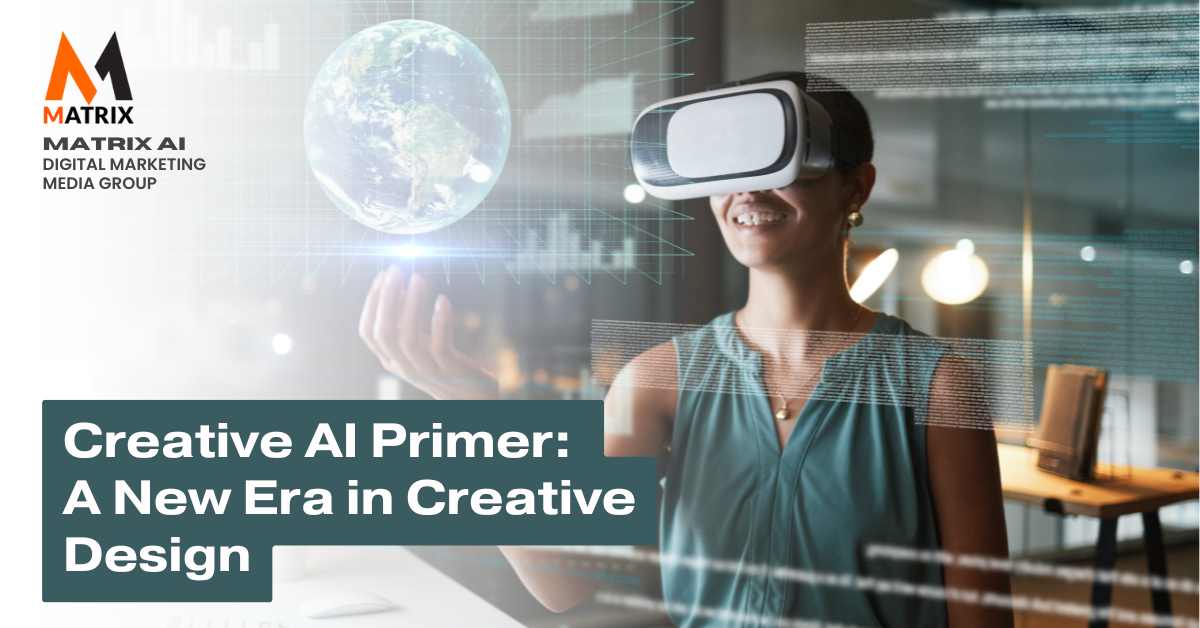Unleashing the Power of Creative AI: A Guide for Content Managers
Did you know that by 2025, AI will generate 90% of all creative content?
This staggering statistic highlights the rapid evolution of technology and underscores the critical importance of understanding and integrating AI into creative processes.
This transformation presents both an exciting opportunity and a potential challenge for content managers.
The Missed Opportunity

Maya Ellis, a content manager in her mid-30s, had always prided herself on her intuition. After ten years in corporate marketing, she felt she had mastered the craft of storytelling. She knew how to hook an audience, weave brand narratives, and drive engagement. She didn’t know that the very foundation of her expertise was about to be shaken.
Maya worked for a growing tech company that prided itself on innovation. Despite her hesitation toward the latest trends in AI-driven content creation, her boss, Daniel, was enthusiastic about bringing creative AI into the company’s marketing strategy. “Maya, this will revolutionize how we work,” he said one morning in a meeting. “Think of how much more we could do with the help of AI.”
Maya dismissed his excitement with a polite nod. “AI can’t replicate creativity,” she thought. She held firmly to this belief: AI could crunch data, maybe even generate a blog post, but it could never replace the human touch her team brought to campaigns. She relied on the spark of inspiration from her brainstorming sessions, not some algorithmic process.
Months passed, and the company decided to adopt a creative AI Digital Marketing Agency and its AI platform, AIContentPad.
Maya’s team worked with Matrix to tune text content and later video for blog posts, social media content, and even video scripts.
While her colleagues were excited about the potential time savings and new possibilities, Maya felt threatened. She feared this technology would undermine the craftsmanship she’d spent her career perfecting.
The first week with AIContentPad was rocky. The AI-generated content felt robotic to her, too structured. Maya sent feedback after feedback, convinced that the AI’s lack of soul was proof of its inferiority. But over time, something changed.
The AI began to learn through tuning and grounding. It started creating more engaging copy, generating ideas Maya’s team hadn’t considered. Her colleagues began embracing the tool, praising its ability to churn out innovative headlines, SEO-friendly blog posts, and even detailed market analyses—all in half the time.
Maya, however, couldn’t let go. She pushed back hard, vetoing AI-generated work whenever she could. She rewrote content herself, meticulously fine-tuning pieces until they felt “human.” She didn’t realize that her over-editing was slowing down her team. Deadlines started slipping, and other departments began whispering about her resistance to change. “Maya doesn’t trust the future,” they’d say.
One day, Daniel called her into his office. He was direct but not unkind. “You’ve got a brilliant mind, Maya. But you’re holding us back.” She was shocked. “Holding you back? I’m just trying to maintain our standards.”
Daniel sighed, leaning forward. “AIContentPad is part of our future. It’s part of corporate marketing’s future. AI is no longer a tool we can ignore—it’s an ally. It’s learning faster than we ever could. If we combine that with your vision, we can accomplish great things. But you have to stop fighting it.”
Maya left the office feeling unsettled. For the first time, she wondered if she had been wrong. Had she been so focused on protecting her craft that she’d overlooked the potential to enhance it?
The turning point came during the annual marketing review. AIContentPad helped the company launch three major campaigns in six months with measurable results. Engagement was up by 40%, conversions by 30%.
The data was undeniable. What hit Maya the hardest was seeing the success of an AI-generated campaign that she had rejected but that the team embraced without her final approval. It was brilliant—creative, dynamic, and exactly what their audience needed.
For the first time, Maya felt the sting of irrelevance. The power of creative AI wasn’t in replacing her—it was in elevating her work.”
Over the next few weeks, Maya began to change her approach. Instead of battling InspireX, she began collaborating with it. She realized that while the AI could handle the heavy lifting of content production—generating ideas, drafting outlines, and even automating the more repetitive tasks—her true strength lay in curating, refining, and injecting the human touch where it mattered most.
The AI could analyze millions of data points and predict the audience’s response. Still, Maya’s experience, intuition, and emotional intelligence could make the message resonate on a deeper level.
Her team flourished. They could launch campaigns faster, test different variations, and adapt strategies in real time based on the AI’s data-driven insights. Maya no longer saw herself as threatened by AI. Instead, she realized that creative AI had given her more space to focus on strategy, storytelling, and connecting with their audience.
But Maya never forgot that moment—she failed to recognize the power of creative AI. The opportunity to embrace the future had almost slipped her fingers simply because she had clung to the past.
In her mid-30s, she had almost let herself become obsolete. Instead, she learned that the key to surviving in an evolving landscape wasn’t to resist change—it was to adapt, embrace, and grow alongside it.
In the end, Maya understood that the future of corporate marketing wasn’t just about AI or human creativity. It was about the synergy between the two. Together, they were unstoppable.
Addressing Common Concerns
One of the primary concerns among content managers is the fear that AI might replace human creativity. However, it’s important to recognize that AI is not here to replace but to augment human talent.
Think of AI as a collaborative tool that can handle repetitive tasks, analyze vast amounts of data, and provide insights that fuel creative strategies. This partnership allows human creatives to focus on what they do best—ideating and innovating.
Transparency and Trust
Another significant worry is the transparency of AI-generated content. Content managers must ensure their AI tools are reliable and produce high-quality, authentic content. OpenAI’s GPT-4, for instance, has been extensively tested and refined to ensure it meets rigorous standards. Content managers can maintain the integrity and authenticity of their creative outputs by choosing well-vetted AI tools.
Evidence-Based Recommendations
Consider starting with a hybrid approach to harness AI’s potential in creative design fully. Implement AI tools for tasks like data analysis, keyword generation, and basic content drafts, and then refine and personalize these drafts with human creativity. Research has shown that such a combined approach can increase productivity by up to 40%, allowing teams to produce more content without compromising quality.
In conclusion, embracing AI in creative design is not just about keeping up with trends; it’s about enhancing the creative process and staying ahead of the curve. By addressing concerns, ensuring transparency, and following evidence-based recommendations, content managers can confidently navigate this new era in creative design.## Creative AI Primer: A New Era in Creative Design
What is Creative AI?
Creative AI refers to applying artificial intelligence to foster creativity in various fields, such as art, design, music, and content creation. Leveraging state-of-the-art technologies like machine learning, neural networks, and generative models, Creative AI systems can generate original and innovative outputs that rival or augment human creativity. This involves automating mundane tasks and providing novel solutions and inspirations, expanding the horizons of creative possibilities.
Why Embrace Creative AI?
The integration of Creative AI offers multifaceted benefits. For content managers, it can significantly enhance productivity by automating repetitive tasks and freeing up valuable time for strategic planning and creativity.
It also creates new avenues for originality and experimentation, fostering an innovative organizational culture.
As AI continues to evolve, its ability to analyze vast data sets and predict trends can offer deep insights into audience preferences, enabling more personalized and engaging content.
Where is Creative AI Transforming Industries?
Creative AI is making waves across numerous industries. In marketing, AI-driven design tools create visually compelling advertisements tailored to specific demographics.
AI-generated scripts, music scores, and artworks are becoming increasingly commonplace in media and entertainment. Fashion designers use AI to predict trends and create avant-garde designs, while architects harness AI to design more efficient and aesthetically pleasing structures.
As these technologies become more sophisticated, their impact on the creative industry will expand, ushering in unprecedented innovation and efficiency.
Immerse yourself in the transformative potential of Creative AI and stay ahead in the evolving landscape of creative design.## Are you Struggling with a Lack of Creative AI Design Experience?
The Agonizing Reality: Inefficient Content Creation
Content managers everywhere grapple with an ever-present hurdle: a profound lack of creative AI design experience. This gap isn’t just a minor inconvenience.
It’s a barrier that stifles creativity, halts innovative campaigns, and leaves you behind competitors who’ve harnessed the power of AI to rejuvenate their content.
Imagine the countless hours spent tweaking designs, reworking strategies, and brainstorming with minimal output – pure frustration.
The Consequences: Stunted Growth and Lost Opportunities
Without a robust grasp of AI design, content production slows to a snail’s pace. Deadlines are missed, and your brand’s creative vision gets lost in translation.
This is no mere inconvenience; it’s a critical roadblock that leads to lost opportunities, reduced engagement, and stunted growth.
Every moment your team spends mired in manual, uninspired content creation translates to your rivals forging ahead, capturing the audience you’ve worked so hard to cultivate.
The Answer: Elevate Your Content with Our AI Marketing Solutions
Say goodbye to creative bottlenecks. Our advanced AI marketing solutions are specifically designed to overcome these barriers.
Imagine AI-driven tools that streamline and enhance your creative processes with innovative design capabilities.
With our solutions, you can produce high-quality, engaging content in a fraction of the time, allowing you to focus on scaling your efforts and driving real results.
Don’t be left behind. Unleash the full potential of your content and gain a competitive edge with our cutting-edge AI marketing solutions.
Begin your journey to effortless creativity and unparalleled innovation today.
Expert Opinions on Creative AI Primer: A New Era in Creative Design

“Transformative Tool for Designers”
Creative AI is revolutionizing the design industry, and renowned designer Jane Smith couldn’t agree more. “I’ve been in the field for over 15 years, and Creative AI is a game-changer. It seamlessly merges creativity with technology, allowing designers to push what’s possible. The intuitive interface and powerful AI algorithms enhance our creative process, offering new and innovative solutions that we couldn’t have imagined before,” Smith states. “Its ability to adapt and learn from our inputs provides a custom experience tailored to each project’s needs. It’s truly a transformative tool.”
“Elevating Content Management to New Heights”
Veteran content manager Robert Jackson shares his enthusiastic experience with Creative AI. “Managing content has never been this streamlined. The AI capabilities of this tool help us generate high-quality, engaging content at incredible speed,” says Jackson. “It deciphers audience preferences and tailors content to maximize engagement, making it indispensable for anyone serious about content strategy. In a world where content is king, having a tool like Creative AI is like having an ace up your sleeve.”
Real-world Impact and Efficiency
Marketing specialist Lisa Chen offers her insights: “Creative AI and AIContentPad is not just for designers; it’s also a boon for marketing teams,. The AI-driven analytics provide in-depth insights that were previously hard to extract.
It’s like having a second brain that processes data and suggests the best creative approaches based on trends and audience behavior,” Chen points out. “This efficiency in design and content creation not only saves time but also ensures that our output is always top-notch.”
Curiosity and Engagement
These testimonials underscore the multifaceted capabilities of Creative AI, sparking curiosity among designers and content managers alike.
The tool’s innovative approach is set to redefine how creative projects are undertaken, promising a new era where technology and creativity seamlessly converge.
Isn’t it time to explore what this AI marvel can do for your creative endeavors?
Unlocking the Future: Creative AI Primer in Design
Harnessing AI for Unparalleled Innovation
In the ever-evolving landscape of creative design, integrating AI is no longer a futuristic concept but a present-day reality that revolutionizes how creativity is harnessed.
Brands that master this integration not only stand out but redefine industries.
Take, for instance, LuminaNova, a relatively unheard-of design studio that utilized AI-driven algorithms to craft bespoke digital art pieces.
By analyzing a vast array of aesthetic data points, LuminaNova created unique and personalized artworks that resonated deeply with their clients, showcasing the transformative potential of AI in creative endeavors.
Pioneering Personalized Experiences
Personalization is at the heart of effective design, and AI-driven tools enable a level of customization previously unattainable.
Cobaltic is a prime example of a niche furniture company that leverages AI to tailor design solutions to individual preferences.
Through machine learning, Cobaltic analyzes customer inputs on styles, materials, and ergonomics, presenting designs that meet and exceed expectations.
This personalized approach enhances customer satisfaction and establishes a profound connection between the brand and its users.
Enhancing Efficiency and Creativity
AI in creative design is not just about aesthetics—it’s also about enhancing efficiency. NeuroFlare, a traditional marketing agency, has successfully implemented AIContentPad to streamline its creative processes.
By automating mundane tasks like data analysis and trend forecasting, NeuroFlare freed their designers to focus on more innovative aspects of their work.
The results? Stunning, data-informed campaigns that are both creative and impactful, demonstrating that AI can be a powerful ally in the creative toolbox.
Conclusion: Embrace the AI-Driven Creative Renaissance
As these emerging brands—LuminaNova, Cobaltic, and NeuroFlare—demonstrate, the strategic implementation of AI in creative design is not just feasible but immensely beneficial.
By embracing AI, designers and brands can push the boundaries of creativity, deliver highly personalized experiences, and operate with unparalleled efficiency.
This new era in creative design is just beginning, and those who adapt will undoubtedly lead the charge into a brilliantly innovative future.
Introduction to Matrix: Revolutionizing Creative Design
As the intersection of artificial intelligence (AI) and creativity grows, Matrix stands at the forefront, pioneering a new era in creative design.
This primer aims to spark curiosity and engagement, highlighting Matrix’s transformative impact on your creative processes.
What is Matrix’s AIContentPad?
Matrix’s AIContentPad is an advanced AI platform designed specifically to enhance and expand the creative capabilities of designers, artists, and innovators.
By leveraging machine learning algorithms and neural networks, Matrix offers tools to generate, refine, and inspire new ideas.
From boardrooms to design shops with a few concept ideas, we can generate and expand the concept into high-converting content audiences love.
Getting Started with Matrix
Explore Matrix’s intuitive user interface to begin your journey. Whether you’re a novice or a seasoned professional, Matrix offers tutorials and a knowledge base that will guide you through setting up your first project.
As you familiarize yourself with its features, you’ll discover how easy it is to integrate AI into your creative workflow.
Exploring Creative Possibilities
One of Matrix’s standout features is its ability to generate creative concepts that enhance your vision. The platform allows you to input basic ideas and see them transformed into complex designs.
This isn’t about replacing the human touch but augmenting it—Matrix acts as a collaborative partner, suggesting variations and innovative approaches you might not have considered.
By immersing yourself in Matrix, you gain a powerful tool and join a community of forward-thinking creatives and technologists who push the boundaries of what’s possible in design. Get ready to elevate your creativity to unprecedented heights.
The Dawn of Creative AI: Revolutionizing Design

Unleashing Creative Potential
In the groundbreaking exploration “Creative AI Primer: A New Era in Creative Design,” the authors explore the transformative power of Artificial Intelligence (AI) in creativity and design.
This pioneering work reveals how AI tools assist and enhance human creativity, significantly changing the landscape of various creative disciplines. AI opens new avenues for innovation and experimentation, from generating artwork to drafting architectural designs.
Bridging Human Imagination and Machine Precision
What stands out is the symbiotic relationship between human intuition and machine precision. The primer highlights that AI acts as a collaborator, augmenting human designers’ capabilities rather than replacing them.
Algorithms can handle repetitive tasks, analyze vast datasets, and provide insights that might elude even the sharpest human minds, freeing designers to focus on more conceptual and inventive aspects of their work.
Practical Applications and Ethical Considerations
Real-world applications are meticulously examined, ranging from fashion design, where AI suggests trendsetting apparel, to music composition, which assists in crafting harmonious pieces. Equally important is the discussion on ethical considerations.
As AI systems become more entwined with creative processes, issues of authorship, originality, and the potential for bias in AI-generated outputs are critically analyzed, urging a balanced and responsible integration of technology in the creative arts.
“Creative AI Primer: A New Era in Creative Design” is an essential read for anyone curious about the future of creativity. It leaves readers intrigued by the boundless possibilities while thoughtfully weighing the ethical fundamentals essential for a harmonious tech-human pathway in artistic innovation.

